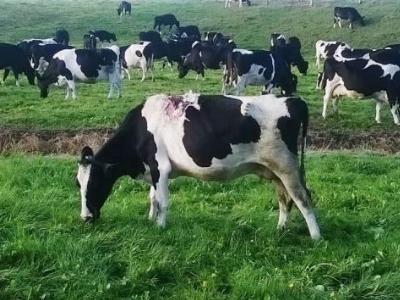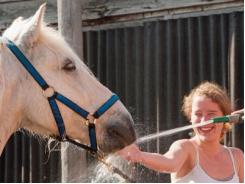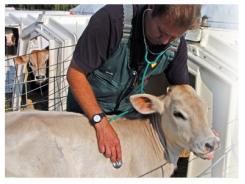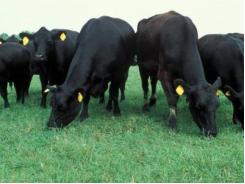Cow Health: Facial Eczema (FE)

Facial Eczema (FE) is a disease which causes lowered production, skin irritation and peeling and sometimes death
Facial eczema is caused by a toxin (sporisdesim) produced by the spores of the fungus Pithomyces chartarum growing on pasture. The fungus grows in the dead litter at the base of pasture in warm moist conditions.
Sporisdesim, when ingested by cattle, damages the liver and bile ducts.
The damaged liver cannot rid the body of wastes and a breakdown product of chlorophyll builds up in the blood causing sensitivity to sunlight, which in turn causes inflammation of the skin.
Signs to look for
- a drop in milk production
- cows are restless, seeking shade and lick their udder
- exposed unpigmented or thin skin reddens, thickens and peels
Not all animals affected with FE show physical signs (i.e. clinical FE) although liver damage (i.e. subclinical FE) has occurred. It is estimated that for every clinical case there will be 10 cows with subclinical FE.
Milk production of animals with subclinical FE can be depressed by up to 50%. Blood tests can be used to monitor the extent of subclinical FE.
Badly damaged liver tissue will not regenerate. Chronic wasting and/or death may occur at the time of damage or months later when the animal is under stress (e.g. calving).
Timing
The fungus produces spores when grass minimum temperatures are above 12°C for two or three nights and humidity is high (usually January to May).
The fungus grows on soft litter at the base of the pasture so hard grazing during danger periods increases the risk of spore intake as does topping which increases the build-up of soft litter.
Prevention
There is no cure for FE so prevention is the only way of protecting animals. To be effective, preventative measures need to be in place before eczema spores are found.
Preventative measures include monitoring pasture spore count and either dosing animals with zinc or spraying pastures with a fungicide.
Breeding cows that are more tolerant to facial eczema is a solution to reduce the impact from facial eczema in the long term.
Facial eczema tolerant genetics
Facial eczema tolerance is a heritable trait and the right breeding programme can reduce the severity of the disease over time.
Research and development completed by CRV Ambreed, AgResearch and DairyNZ resulted in the ability to identify facial eczema tolerant bulls. These sires will typically breed off-spring that are 25% less reactive to a facial eczema challenge, compared to the average bull.
By selecting the right bull team - and using genetics alongside other farm management practices - you can help increase your herd’s tolerance to FE challenges.
Cows resulting from FE tolerant sires will typically have:
- Improved tolerance to FE spores
- Improved production
For a herd starting a breeding programme with FE tolerant sires the first benefits (FE tolerance in young stock) are not available for 18 months after first insemination. Gains in FE tolerance will be made as each generation of daughters from FE sires enters the herd. A full herd with FE tolerance is achievable in 7-8 years.
For more information see
CRV Ambreed Facial Eczema tolerant genetics
Monitor pasture spore count
Pasture spore counting is an excellent way to visualise spore count trends and to get a handle on the likely risk. It is highly variable between paddocks but as a guide:
| Risk level | |
| Low | Less than 15,000/g of pasture |
| Slight | 15,000-30,000 (begin zinc treatment if trending to 30,000) |
| Moderate | 30,000-60,000 |
| High | Greater than 60,000 |
- Monitor regional spore counts.
- Monitor farm spore counts: when regional spore counts reach 20,000 spores/g of pasture begin to monitor farm spore counts.
Choose 4 paddocks that are representative of the farm and monitor.
Tips for predicting the most susceptible paddocks for spore counting
- Spore counts on north and west facing slopes are usually higher than east and south facing slopes.
- Paddocks with a lot of pasture litter and those that are well sheltered often have higher counts.
Sampling process
- Collect a sample of pasture from the next paddock to be grazed, clipping to grazing height and collecting about a bread bag of pasture. Avoid sheltered areas.
- Store the sample in the fridge if not processing immediately.
- Weigh out a 60g subsample of pasture into a jar. Add 600ml of water and then shake for 3 minutes.
- Apply a drop of the water to each side of a haemocytometer or blood counting slide. Under a microscope count the number of spores in the centre and corner grids on each side of the slide.
- Rinse slide with water, dry with paper towel, then repeat step 4.
- Multiply total number of spores counted by 5,000 to get spore count (number of spores per gram of fresh pasture).
Zinc dosing
Start early – at least two to three weeks before the spore growth danger period.
Weigh a representative sample of at least 20 cows of each of the mobs to be treated to calculate the dose of zinc required.
Fully dose cows with zinc: drenching with zinc oxide, water dosing with zinc sulphate, administering in feed or as an intraruminal bolus (e.g. Time Capsule, Face-Guard).
The more control a farmer has over the amount of zinc a cow receives the more likely it is that the cows are receiving the correct daily dose. Zinc drenching and intraruminal bolus will, for this reason, provide more reliable protection than adding zinc sulphate to drinking water.
Zinc is toxic in high doses; care should be taken in calculating dose rates.
For more information see:
- Facial eczema: management for New Zealand dairy herds
- Steps to managing facial eczema using zinc
- Farmfact 3-7 for dose rates and drench recipes.
Pasture spraying
Spraying the pasture with a fungicide will slow the development of the fungus and subsequent production of spores.
Apply only when:
- Pasture has confirmed spore counts below 20,000
- Pasture is green and growing.
Spraying should cover all areas including fence lines and under hedges.
Check spore counts after spraying and before grazing, to ensure pastures are below acceptable levels. Pasture will be safe for 4-6 weeks after which they will need to be resprayed or monitored with spore counting.
Pasture management
- Minimise the build-up of soft litter through avoiding topping and managing pasture quality in November/December.
- Avoid grazing below 4cm pasture height during summer months; use supplements to reduce grazing pressure.
Treatment
Cows showing clinical signs of facial eczema can recover if prompt action is taken
- Dry off affected cows now, to reduce pressure on the liver
- Put zinc cream on white areas of the coat and the udder (if affected)
- Move affected stock into dense shade. Indoors is best (hay-barn, calf-rearing and implement sheds) but make sure there is a good water supply and supplementary feed available for cows
- Feed cows at night, so they are not exposed to sunlight and stop hard grazing so cows do not graze down into dead matter where the spores that cause FE live
- Feeding maize and/or silage can help, but cows will still tend to graze if they are kept on pasture
- Make sure the diet is balanced, with good levels of energy and protein.
In addition to the above, for very sick cows
- Use a starter drench to boost metabolic function
- Use vitamin B12 supplementation
- Seek veterinary advice regarding additional pain relief treatment.
Practical indicators of recovery include liveweight gain and improvement in body condition score (BCS). Be aware that animals can take up to 12 months to fully recover.
Animals with a previous history of clinical FE have a lower chance of recovery than previously unaffected animals.
When making decisions to cull cows act early before body condition score and the severity of the condition cause unnecessary distress and suffering. If sending cows for processing farmers need to be aware that animals will not be accepted if emaciated or with severe skin damage (sores, weeping wounds etc.).
Resources:
- Facial eczema: management for New Zealand dairy herds
- Steps to managing facial eczema using zinc
- Farmfact 3-6: Facial eczema – treatment and prevention
- Farmfact 3-7: Facial eczema – zinc treatment, recipes and dose rates
Related news
Tools

Phối trộn thức ăn chăn nuôi

Pha dung dịch thủy canh

Định mức cho tôm ăn

Phối trộn phân bón NPK

Xác định tỷ lệ tôm sống

Chuyển đổi đơn vị phân bón

Xác định công suất sục khí

Chuyển đổi đơn vị tôm

Tính diện tích nhà kính

Tính thể tích ao




 Cow Health: Grass staggers
Cow Health: Grass staggers  Cow Health: Bovine viral diarrhoea virus
Cow Health: Bovine viral diarrhoea virus